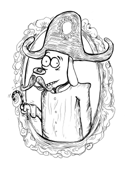

Welcome to Candyland
It’s always hard to go back and look at something the way you first saw it once your opinion has changed. Luckily, I had a pen in hand at the opening for the Peter Doig painting exhibition at the Arts Club of Chicago. So I jotted down my first thoughts, a good place to start, and then we can work from there.
I somehow found myself at the Peter Doig opening as a member of the press. Doig
is kind of a hot new painter. He comes from the “bad” tradition,
like Sigmar Polke, you know, “I’m an inadequate painter, isn’t
that funny?” They also compare him to Richter. Oh! Everybody loves them!
The way he handles paint on canvas is just a bit like the way they do. The way
the paint is scraped across the surface of the canvas looks like tiny bits of
Polke’s halftone dots.
In the exhibition press release he’s quoted in an interview as saying,
“Often I am trying to create a sense of ‘numbness.’”
Well, I am certainly uncomfortable looking at them. I can’t tell if they
are ugly or not. They are odd, difficult paintings. There’s too much going
on to be “non-paintings” like Luc Tuymans, and they aren’t
infantile and stupid like Laura Owens either. They make me think of funny German
abstractionist Thomas Scheibitz, even though Scheibitz is very smooth and regular
in his application of paint; Doig changes up his surfaces and applications.
Both have a humor about their work, yet there is also a sense of extreme passion
in the act of painting that is serious and not at all sarcastic. Doig’s
paintings are very raw, but aesthetically raw, not expressive and emotionally
raw. It’s ugly, brutal paint and surface, not ugly, brutal flesh, like
Francis Bacon.
His handling of the medium, from thick to thin paint application, seems very
Modernist. Doig’s work harkens back to the days of Pierre Bonnard and
Édouard Vuillard or Toulouse-Lautrec, when it was quite acceptable to
enjoy the act of painting. It’s not like today when, if you are dumb enough
to paint, it better be cold and sarcastic.
The paintings kind of grow on you, especially the color. They’re fucking
weird, though. Grubby and muddy with these movements of vibrant color. Puce,
pea green, purple, brown, and then a streak of vibrant red. They are sloppy
messes, but when you look up close you see all this quick, precise linework.
Slop juxtaposed with intentionality. The paintings hover between beautiful and
ugly, genuine and false.
These paintings hint at history —not just art history, but history in
general. They remind you of a specific time and place that you can’t quite
fixate on. Like when you have a certain experience in a certain place, but forget
the details — that’s what these paintings are. My favorite painting
in the exhibition is “Gasthof zur Muldentalsperre,” because it holds
within it all the things I’ve written about: implied narrative, humor,
and ambiguous historical references. Roughly translated, “Gasthof zur
Muldentalsperre” is “Guest Stop on the Muldentalsperre.” But
the painting itself seems to indicate nothing of a German location. Two men
in uniform, on the nightshift, guard the gate to a strange land, walled in by
whipped cream and Juji Fruits. They smile and say: “Welcome to Candyland!”
That’s what all the paintings say as you go from hating them to loving
them. Art that you immediately love gets boring fast. It’s good, it’s
great, so what? Art that makes you work for it commands more attention. We’re
all lazy and when a big painting stares down at you and gets you off your ass
to work for the experience of viewing it, something magical happens.
Illustration by Erik Wenzel